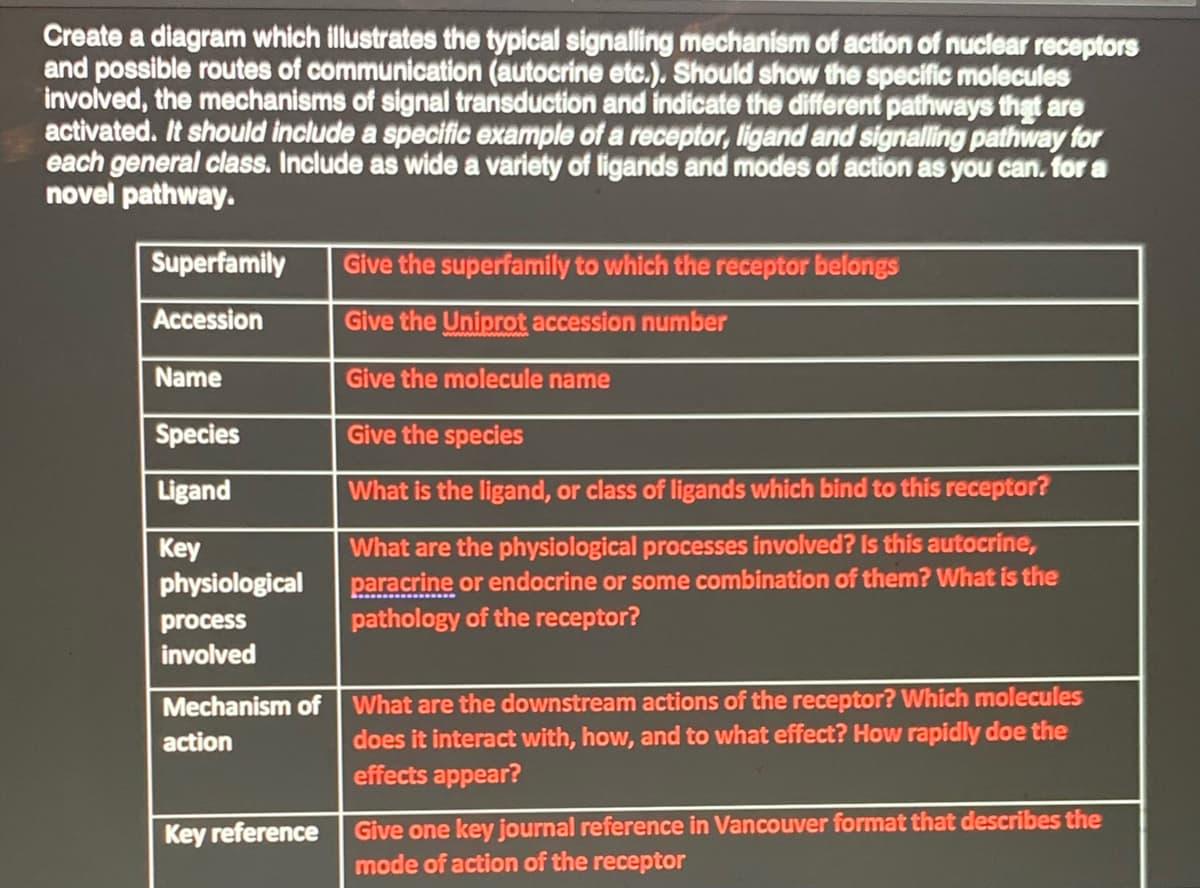novel pathway. Superfamily Give the superfamily to which the receptor belongs Accession Give the Uniprot accession number Name Give the molecule name Species Give the species Ligand What is the ligand, or class of ligands which bind to this receptor? What are the physiological processes involved? Is this autocrine, paracrine or endocrine or some combination of them? What is the pathology of the receptor? Key physiological process involved Mechanism of What are the downstream actions of the receptor? Which molecules does it interact with, how, and to what effect? How rapidly doe the effects appear? action
novel pathway. Superfamily Give the superfamily to which the receptor belongs Accession Give the Uniprot accession number Name Give the molecule name Species Give the species Ligand What is the ligand, or class of ligands which bind to this receptor? What are the physiological processes involved? Is this autocrine, paracrine or endocrine or some combination of them? What is the pathology of the receptor? Key physiological process involved Mechanism of What are the downstream actions of the receptor? Which molecules does it interact with, how, and to what effect? How rapidly doe the effects appear? action
Biology (MindTap Course List)
11th Edition
ISBN:9781337392938
Author:Eldra Solomon, Charles Martin, Diana W. Martin, Linda R. Berg
Publisher:Eldra Solomon, Charles Martin, Diana W. Martin, Linda R. Berg
Chapter6: Cell Communication
Section: Chapter Questions
Problem 1TYU: During signal transduction (a) the cell converts an extracellular signal into an intracellular...
Related questions
Question

Transcribed Image Text:Create a diagram which illustrates the typical signalling mechanism of action of nuclear receptors
and possible routes of communication (autocrine etc.). Should show the specific molecules
involved, the mechanisms of signal transduction and indicate the different pathways thgt are
activated. It should include a specific example of a receptor, ligand and signalling pathway for
each general class. Include as wide a variety of ligands and modes of action as you can. for a
novel pathway.
Superfamily
Give the superfamily to which the receptor belongs
Accession
Give the Uniprot accession number
Name
Give the molecule name
Species
Give the species
Ligand
What is the ligand, or class of ligands which bind to this receptor?
Key
physiological
What are the physiological processes involved? Is this autocrine,
paracrine or endocrine or some combination of them? What is the
pathology of the receptor?
process
involved
Mechanism of What are the downstream actions of the receptor? Which molecules
does it interact with, how, and to what effect? How rapidly doe the
effects appear?
action
Give one key journal reference in Vancouver format that describes the
mode of action of the receptor
Key reference
Expert Solution
This question has been solved!
Explore an expertly crafted, step-by-step solution for a thorough understanding of key concepts.
Step by step
Solved in 2 steps with 1 images

Recommended textbooks for you

Biology (MindTap Course List)
Biology
ISBN:
9781337392938
Author:
Eldra Solomon, Charles Martin, Diana W. Martin, Linda R. Berg
Publisher:
Cengage Learning

Anatomy & Physiology
Biology
ISBN:
9781938168130
Author:
Kelly A. Young, James A. Wise, Peter DeSaix, Dean H. Kruse, Brandon Poe, Eddie Johnson, Jody E. Johnson, Oksana Korol, J. Gordon Betts, Mark Womble
Publisher:
OpenStax College

Biology (MindTap Course List)
Biology
ISBN:
9781337392938
Author:
Eldra Solomon, Charles Martin, Diana W. Martin, Linda R. Berg
Publisher:
Cengage Learning

Anatomy & Physiology
Biology
ISBN:
9781938168130
Author:
Kelly A. Young, James A. Wise, Peter DeSaix, Dean H. Kruse, Brandon Poe, Eddie Johnson, Jody E. Johnson, Oksana Korol, J. Gordon Betts, Mark Womble
Publisher:
OpenStax College